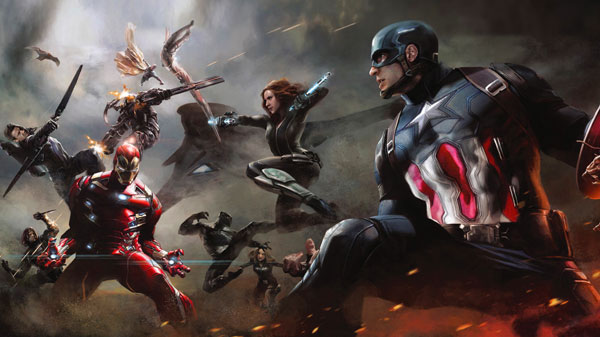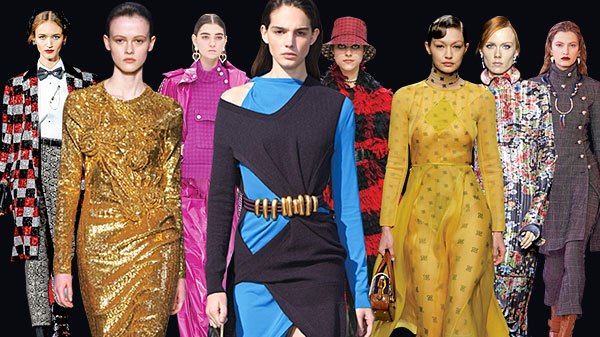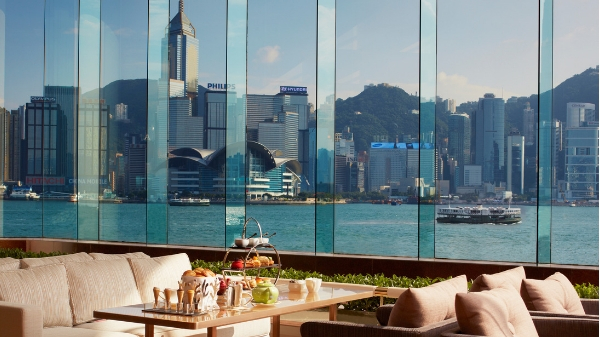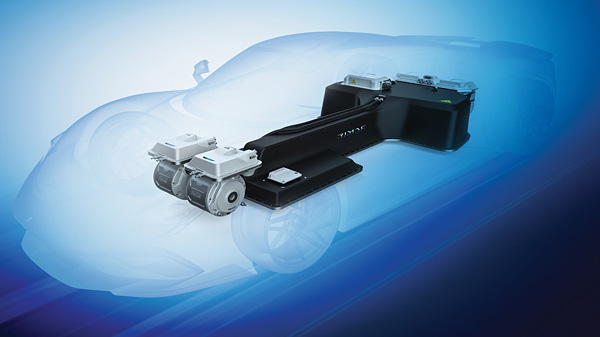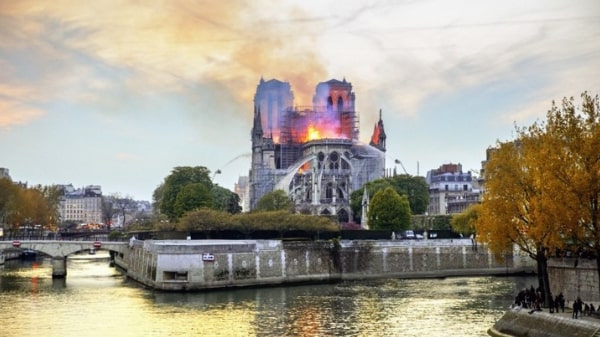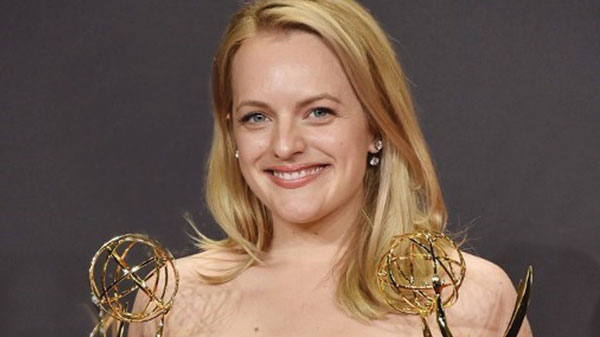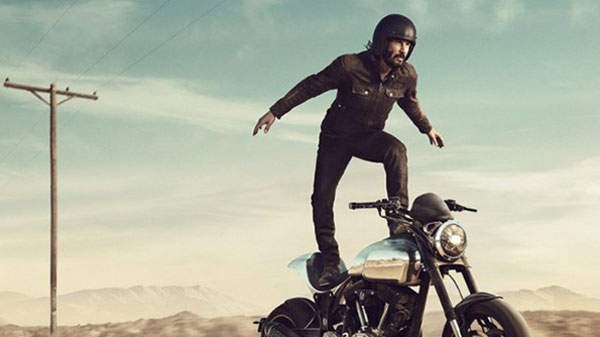With the onset of cooler weather offering a welcome reprieve from the sweltering summer heat, a refreshing array of svelte designs has been served up by the world’s much-loved high-end fashion brands to help femme fashionistas to heat up their wardrobes during the coming months. From shimmering eveningwear and elegant overcoats to evocatively experimental ensembles, there’s something here to appeal to every modern woman. Without further adieu, let’s dive into Part 1 of our coverage of the hottest haute couture looks of Autumn / Winter 2019…
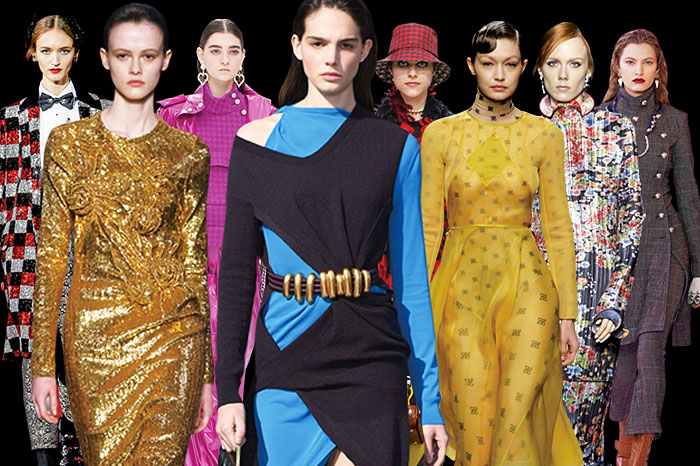
Bottega Veneta
“I like real clothes. I think there’s a need for a return to elegance and sophistication,” Daniel Lee, Bottega Veneta’s creative director, opined before his Autumn / Winter collection hit the catwalk. Indeed, his new women’s line places firm emphasis on wearability and comfort, albeit with an experimental streak, ranging from everyday chic – think sweaters and pants – to more outré offerings like loud leopard-print overcoats, bold black-and-blue cut-out dresses and shimmering evening gowns. Judicious use of leather – an undeniable Bottega signature – underscores every look, be it the form-fitting leather trousers, sleek boots or eye-catching handbags.
[{"id" : "48646","image" : "https://www.gafencushop.com/wp-content/gallery/0910bottegavenetta/Autumn-Winter-Bottega-Veneta-1.jpg","caption" : "Autumn Winter Bottega Veneta 1"},{"id" : "48649","image" : "https://www.gafencushop.com/wp-content/gallery/0910bottegavenetta/Autumn-Winter-Bottega-Veneta-2.jpg","caption" : "Autumn Winter Bottega Veneta 2"},{"id" : "48651","image" : "https://www.gafencushop.com/wp-content/gallery/0910bottegavenetta/Autumn-Winter-Bottega-Veneta-3.jpg","caption" : "Autumn Winter Bottega Veneta 3"},{"id" : "48653","image" : "https://www.gafencushop.com/wp-content/gallery/0910bottegavenetta/Autumn-Winter-Bottega-Veneta-4.jpg","caption" : "Autumn Winter Bottega Veneta 4"},{"id" : "48655","image" : "https://www.gafencushop.com/wp-content/gallery/0910bottegavenetta/Autumn-Winter-Bottega-Veneta-5.jpg","caption" : "Autumn Winter Bottega Veneta 5"},{"id" : "48657","image" : "https://www.gafencushop.com/wp-content/gallery/0910bottegavenetta/Autumn-Winter-Bottega-Veneta-6.jpg","caption" : "Autumn Winter Bottega Veneta 6"},{"id" : "48659","image" : "https://www.gafencushop.com/wp-content/gallery/0910bottegavenetta/Autumn-Winter-Bottega-Veneta-7.jpg","caption" : "Autumn Winter Bottega Veneta 7"},{"id" : "48661","image" : "https://www.gafencushop.com/wp-content/gallery/0910bottegavenetta/Autumn-Winter-Bottega-Veneta-8.jpg","caption" : "Autumn Winter Bottega Veneta 8"}]
Burberry
For his sophomore Burberry collection, its Italian chief creative officer Riccardo Tisci apparently drew inspiration from the “contrasts in British culture and weather”. It is a study in contrasts indeed, as short, flirtatiously fringed dresses and shimmering sequined gowns vie with rigidly-shouldered coats and silhouette-hiding vests for attention. An aura of defiance against the tense socio-political pre-Brexit atmosphere is wholly perceptible throughout, while Tisci’s affinity for streetwear also makes an appearance in the form of puffy bomber jackets, layered rugby shirts and unambiguously utilitarian footwear.
[{"id" : "48664","image" : "https://www.gafencushop.com/wp-content/gallery/0910burrberry/Autumn-Winter-Burberry-1.jpg","caption" : "Autumn Winter Burberry 1"},{"id" : "48667","image" : "https://www.gafencushop.com/wp-content/gallery/0910burrberry/Autumn-Winter-Burberry-2.jpg","caption" : "Autumn Winter Burberry 2"},{"id" : "48669","image" : "https://www.gafencushop.com/wp-content/gallery/0910burrberry/Autumn-Winter-Burberry-3.jpg","caption" : "Autumn Winter Burberry 3"},{"id" : "48671","image" : "https://www.gafencushop.com/wp-content/gallery/0910burrberry/Autumn-Winter-Burberry-4.jpg","caption" : "Autumn Winter Burberry 4"},{"id" : "48673","image" : "https://www.gafencushop.com/wp-content/gallery/0910burrberry/Autumn-Winter-Burberry-5.jpg","caption" : "Autumn Winter Burberry 5"},{"id" : "48675","image" : "https://www.gafencushop.com/wp-content/gallery/0910burrberry/Autumn-Winter-Burberry-6.jpg","caption" : "Autumn Winter Burberry 6"},{"id" : "48677","image" : "https://www.gafencushop.com/wp-content/gallery/0910burrberry/Autumn-Winter-Burberry-7.jpg","caption" : "Autumn Winter Burberry 7"},{"id" : "48679","image" : "https://www.gafencushop.com/wp-content/gallery/0910burrberry/Autumn-Winter-Burberry-8.jpg","caption" : "Autumn Winter Burberry 8"}]
Chanel
Haute couture maison Chanel bid farewell to its iconic creative director, the late and much-lamented Karl Lagerfeld, by celebrating his final creations – its Autumn / Winter 2019 line – in a majestic, winter-wonderland fashion. Fittingly imbued with the sense of irreverent playfulness that marked so many of his works, the collection celebrates femininity in all its multifaceted glory, be it the classically-elegant wide-legged trouser suits of the modern working woman, the princess chic of a snow-white miniskirt or the unassailable magnetism of an eye-popping all-purple ensemble. Blending tradition with modernity in a flair all his own, it is a fitting finale for one of fashion’s all-time greats.
[{"id" : "48682","image" : "https://www.gafencushop.com/wp-content/gallery/0910chanel/Autumn-Winter-Chanel-1.jpg","caption" : "Autumn Winter Chanel 1"},{"id" : "48685","image" : "https://www.gafencushop.com/wp-content/gallery/0910chanel/Autumn-Winter-Chanel-2.jpg","caption" : "Autumn Winter Chanel 2"},{"id" : "48687","image" : "https://www.gafencushop.com/wp-content/gallery/0910chanel/Autumn-Winter-Chanel-3.jpg","caption" : "Autumn Winter Chanel 3"},{"id" : "48689","image" : "https://www.gafencushop.com/wp-content/gallery/0910chanel/Autumn-Winter-Chanel-4.jpg","caption" : "Autumn Winter Chanel 4"},{"id" : "48691","image" : "https://www.gafencushop.com/wp-content/gallery/0910chanel/Autumn-Winter-Chanel-5.jpg","caption" : "Autumn Winter Chanel 5"},{"id" : "48693","image" : "https://www.gafencushop.com/wp-content/gallery/0910chanel/Autumn-Winter-Chanel-6.jpg","caption" : "Autumn Winter Chanel 6"},{"id" : "48695","image" : "https://www.gafencushop.com/wp-content/gallery/0910chanel/Autumn-Winter-Chanel-7.jpg","caption" : "Autumn Winter Chanel 7"}]
Chloé
Chloé’s newest seasonal looks are a riot of patterns, fabrics and textures, all intertwined with asymmetrical hemlines, morphing silhouettes and the occasional splash of colour. An apt homage to the ever-evolving nature of haute couture, creative director Natacha Ramsay-Levi has interspersed her more sober offerings – denim jeans and a tee, a billowing overcoat over tweed trousers – with a touch of edginess evident in the wispy floor-length gowns, evocative see-through tops and lacy skirts. Throughout, her only allowance for consistency lies in the talismanic accessories that accentuate most outfits, taking each perfectly-tailored ensemble to new heights.
[{"id" : "48698","image" : "https://www.gafencushop.com/wp-content/gallery/0910chloe/Autumn-Winter-Chlo%C3%A9-1.jpg","caption" : "Autumn Winter Chloé 1"},{"id" : "48701","image" : "https://www.gafencushop.com/wp-content/gallery/0910chloe/Autumn-Winter-Chlo%C3%A9-2.jpg","caption" : "Autumn Winter Chloé 2"},{"id" : "48703","image" : "https://www.gafencushop.com/wp-content/gallery/0910chloe/Autumn-Winter-Chlo%C3%A9-3.jpg","caption" : "Autumn Winter Chloé 3"},{"id" : "48705","image" : "https://www.gafencushop.com/wp-content/gallery/0910chloe/Autumn-Winter-Chlo%C3%A9-4.jpg","caption" : "Autumn Winter Chloé 4"},{"id" : "48707","image" : "https://www.gafencushop.com/wp-content/gallery/0910chloe/Autumn-Winter-Chlo%C3%A9-5.jpg","caption" : "Autumn Winter Chloé 5"},{"id" : "48709","image" : "https://www.gafencushop.com/wp-content/gallery/0910chloe/Autumn-Winter-Chlo%C3%A9-6.jpg","caption" : "Autumn Winter Chloé 6"},{"id" : "48711","image" : "https://www.gafencushop.com/wp-content/gallery/0910chloe/Autumn-Winter-Chlo%C3%A9-7.jpg","caption" : "Autumn Winter Chloé 7"},{"id" : "48713","image" : "https://www.gafencushop.com/wp-content/gallery/0910chloe/Autumn-Winter-Chlo%C3%A9-8.jpg","caption" : "Autumn Winter Chloé 8"}]
Dior
Feminism, sisterhood and the rise of womankind – these are the unquestionable themes shaping Dior creative director Maria Grazia Chiuri’s latest looks. Inspired by Britain’s Teddy Girls – the bold working-class vixens who rejected post-WWII austerity and embraced head-turning, gender-bending garments as their call-to-action – the models are garbed in loud hues and strong checkered patterns in aggressively cut yet undeniable feminine lines. Interspersed with these more dominant designs are form-fitting dresses in a whirl of translucent sequins, ruffled taffeta and seductively high hemlines, proclaiming that in today’s enlightened age, a woman can indulge her delicate side and still remain powerful.
[{"id" : "48716","image" : "https://www.gafencushop.com/wp-content/gallery/0910dior/Autumn-Winter-Dior-1.jpg","caption" : "Autumn Winter Dior 1"},{"id" : "48719","image" : "https://www.gafencushop.com/wp-content/gallery/0910dior/Autumn-Winter-Dior-2.jpg","caption" : "Autumn Winter Dior 2"},{"id" : "48721","image" : "https://www.gafencushop.com/wp-content/gallery/0910dior/Autumn-Winter-Dior-3.jpg","caption" : "Autumn Winter Dior 3"},{"id" : "48723","image" : "https://www.gafencushop.com/wp-content/gallery/0910dior/Autumn-Winter-Dior-4.jpg","caption" : "Autumn Winter Dior 4"},{"id" : "48725","image" : "https://www.gafencushop.com/wp-content/gallery/0910dior/Autumn-Winter-Dior-5.jpg","caption" : "Autumn Winter Dior 5"},{"id" : "48727","image" : "https://www.gafencushop.com/wp-content/gallery/0910dior/Autumn-Winter-Dior-6.jpg","caption" : "Autumn Winter Dior 6"},{"id" : "48729","image" : "https://www.gafencushop.com/wp-content/gallery/0910dior/Autumn-Winter-Dior-7.jpg","caption" : "Autumn Winter Dior 7"}]
Dolce & Gabbana
The staggering 127-look parade that encompasses Dolce & Gabbana’s new seasonal line is a visual smorgasbord to say the least. Dubbed the Eleganza collection, the mammoth anthology is divided into 11 wholly separate sections – Masculine, Colour Block and Tweed, to name but three – each representative of a signature style developed by its two founders over the last 36 years. Advocating a “return to classicality”, the duo have presented an eye-popping array of sophisticated day-tonight wear, from androgynous tweed suits and pants to soft and dreamy “Sleepwear”. Elsewhere, bold leopard prints and beautifully-tailored portrait-print pieces gift the collection with a sense of the outré.
[{"id" : "48732","image" : "https://www.gafencushop.com/wp-content/gallery/0910dolce/Autumn-Winter-Dolce-Gabbana-1.jpg","caption" : "Autumn Winter Dolce & Gabbana 1"},{"id" : "48735","image" : "https://www.gafencushop.com/wp-content/gallery/0910dolce/Autumn-Winter-Dolce-Gabbana-2.jpg","caption" : "Autumn Winter Dolce & Gabbana 2"},{"id" : "48737","image" : "https://www.gafencushop.com/wp-content/gallery/0910dolce/Autumn-Winter-Dolce-Gabbana-3.jpg","caption" : "Autumn Winter Dolce & Gabbana 3"},{"id" : "48739","image" : "https://www.gafencushop.com/wp-content/gallery/0910dolce/Autumn-Winter-Dolce-Gabbana-4.jpg","caption" : "Autumn Winter Dolce & Gabbana 4"},{"id" : "48741","image" : "https://www.gafencushop.com/wp-content/gallery/0910dolce/Autumn-Winter-Dolce-Gabbana-5.jpg","caption" : "Autumn Winter Dolce & Gabbana 5"},{"id" : "48743","image" : "https://www.gafencushop.com/wp-content/gallery/0910dolce/Autumn-Winter-Dolce-Gabbana-6.jpg","caption" : "Autumn Winter Dolce & Gabbana 6"},{"id" : "48745","image" : "https://www.gafencushop.com/wp-content/gallery/0910dolce/Autumn-Winter-Dolce-Gabbana-7.jpg","caption" : "Autumn Winter Dolce & Gabbana 7"},{"id" : "48747","image" : "https://www.gafencushop.com/wp-content/gallery/0910dolce/Autumn-Winter-Dolce-Gabbana-8.jpg","caption" : "Autumn Winter Dolce & Gabbana 8"},{"id" : "48749","image" : "https://www.gafencushop.com/wp-content/gallery/0910dolce/Autumn-Winter-Dolce-Gabbana-9.jpg","caption" : "Autumn Winter Dolce & Gabbana 9"}]
Fendi
Another swansong collection by the late Karl Lagerfeld, Fendi’s Autumn / Winter 2019 show exemplifies the very best of his signature looks. Dominated by warm beige, yellow and orange hues, the boxy cuts and structurally austere lines of the mainly formal offerings have been given a dash of playful accents, be it the oversized bowtie that adorns a square-shouldered leather coat, the Fendi logo-printed leggings or the geometrically intricate gauzy leather dress. The pièce de résistance of the collection is an airy and flirtatiously sheer buttercup-yellow dress worn by model Gigi Hadid to close the show.
[{"id" : "48758","image" : "https://www.gafencushop.com/wp-content/gallery/0910fendi/Autumn-Winter-Fendi-1.jpg","caption" : "Autumn Winter Fendi 1"},{"id" : "48761","image" : "https://www.gafencushop.com/wp-content/gallery/0910fendi/Autumn-Winter-Fendi-2.jpg","caption" : "Autumn Winter Fendi 2"},{"id" : "48763","image" : "https://www.gafencushop.com/wp-content/gallery/0910fendi/Autumn-Winter-Fendi-3.jpg","caption" : "Autumn Winter Fendi 3"},{"id" : "48765","image" : "https://www.gafencushop.com/wp-content/gallery/0910fendi/Autumn-Winter-Fendi-4.jpg","caption" : "Autumn Winter Fendi 4"},{"id" : "48767","image" : "https://www.gafencushop.com/wp-content/gallery/0910fendi/Autumn-Winter-Fendi-5.jpg","caption" : "Autumn Winter Fendi 5"},{"id" : "48769","image" : "https://www.gafencushop.com/wp-content/gallery/0910fendi/Autumn-Winter-Fendi-6.jpg","caption" : "Autumn Winter Fendi 6"},{"id" : "48771","image" : "https://www.gafencushop.com/wp-content/gallery/0910fendi/Autumn-Winter-Fendi-7.jpg","caption" : "Autumn Winter Fendi 7"},{"id" : "48773","image" : "https://www.gafencushop.com/wp-content/gallery/0910fendi/Autumn-Winter-Fendi-8.jpg","caption" : "Autumn Winter Fendi 8"}]
Givenchy
Deftly demonstrating that formalwear can be fun and exuberant, Givenchy’s creative director Clare Waight Keller has freely experimented with varying volumes, layers and patterns while still delivering a wholly sophisticated ladieswear collection – themed as “the winter of Eden” – this season. The most profound of her explorations are to be found in her study of shoulders and sleeves. From ’40s-era square cuts to the ’90s’ shrunkenly sloped lines, from sculpturally rounded styles to a slinky off-shoulder design with a puffed sleeve, Keller ably showcases her undeniable tailoring genius and innate vision with each design.
[{"id" : "48778","image" : "https://www.gafencushop.com/wp-content/gallery/0910givenchy/Autumn-Winter-Givenchy-1.jpg","caption" : "Autumn Winter Givenchy 1"},{"id" : "48781","image" : "https://www.gafencushop.com/wp-content/gallery/0910givenchy/Autumn-Winter-Givenchy-2.jpg","caption" : "Autumn Winter Givenchy 2"},{"id" : "48783","image" : "https://www.gafencushop.com/wp-content/gallery/0910givenchy/Autumn-Winter-Givenchy-3.jpg","caption" : "Autumn Winter Givenchy 3"},{"id" : "48785","image" : "https://www.gafencushop.com/wp-content/gallery/0910givenchy/Autumn-Winter-Givenchy-4.jpg","caption" : "Autumn Winter Givenchy 4"},{"id" : "48787","image" : "https://www.gafencushop.com/wp-content/gallery/0910givenchy/Autumn-Winter-Givenchy-5.jpg","caption" : "Autumn Winter Givenchy 5"},{"id" : "48789","image" : "https://www.gafencushop.com/wp-content/gallery/0910givenchy/Autumn-Winter-Givenchy-6.jpg","caption" : "Autumn Winter Givenchy 6"},{"id" : "48791","image" : "https://www.gafencushop.com/wp-content/gallery/0910givenchy/Autumn-Winter-Givenchy-7.jpg","caption" : "Autumn Winter Givenchy 7"},{"id" : "48793","image" : "https://www.gafencushop.com/wp-content/gallery/0910givenchy/Autumn-Winter-Givenchy-8.jpg","caption" : "Autumn Winter Givenchy 8"}]
Stay tuned for Part 2 of our Autumn / Winter 2019-20 coverage…









